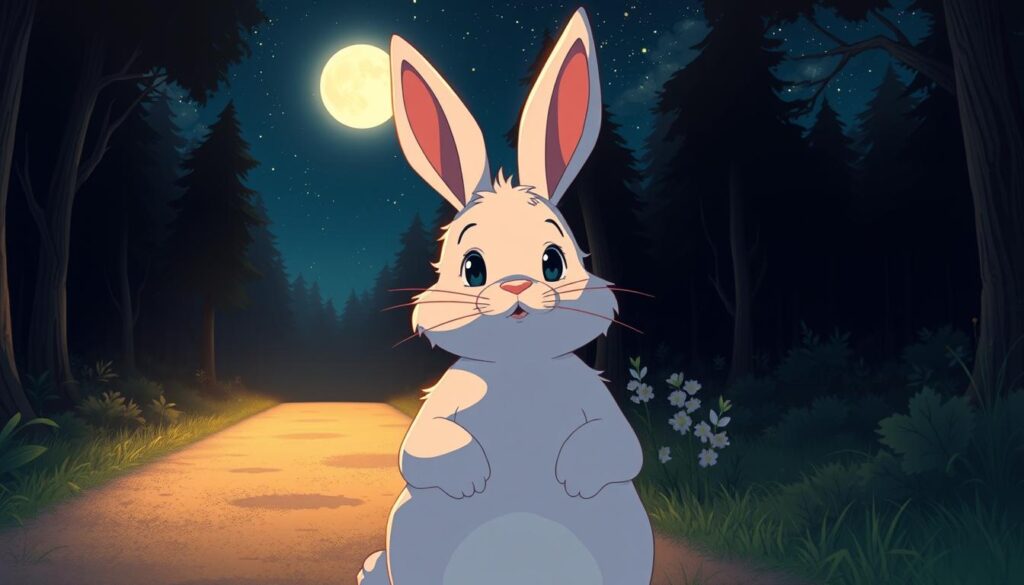As I settled into my favorite chair to read a bedtime story, I noticed my little one clutching the blanket. Their wide eyes darted around the dimly lit room. I remembered how childhood fears often lurked in the shadows of imagination, specially the fear of the dark.
I had stumbled upon the delightful children’s book, The Rabbit Who Was Afraid of the Dark. It had been a beacon of hope for many young readers like my child. The book addresses a timeless concern that resonates with so many of us—overcoming fears.
Reflecting on how this charming tale weaves lessons about courage and light amidst the darkness, I found solace. I knew that stories like these play a key role in helping children articulate and confront their fears. It’s not just an engaging bedtime story; it’s a tool for growth.
It shows how literature can bring forth understanding and empowerment in those terrifying moments faced in the night. Like many parents, I aim to equip my child with the bravery to face the darkness. Guided by relatable characters who journey from fear to self-assurance.
Introduction to Fear in Children
Many parents worry when their kids show fears, like the dark. These fears are normal. About 70% of young kids face some fear during their early years.
Children’s fears often come from their growing imagination. This makes them anxious about things they don’t know.
Fears in kids can change a lot. They might go away and then come back stronger. It’s important for parents and kids to understand these fears.
Even babies can sense danger, like snakes and spiders. This shows that fears have a deep root in us.
Understanding “The Rabbit Who Was Afraid of the Dark”
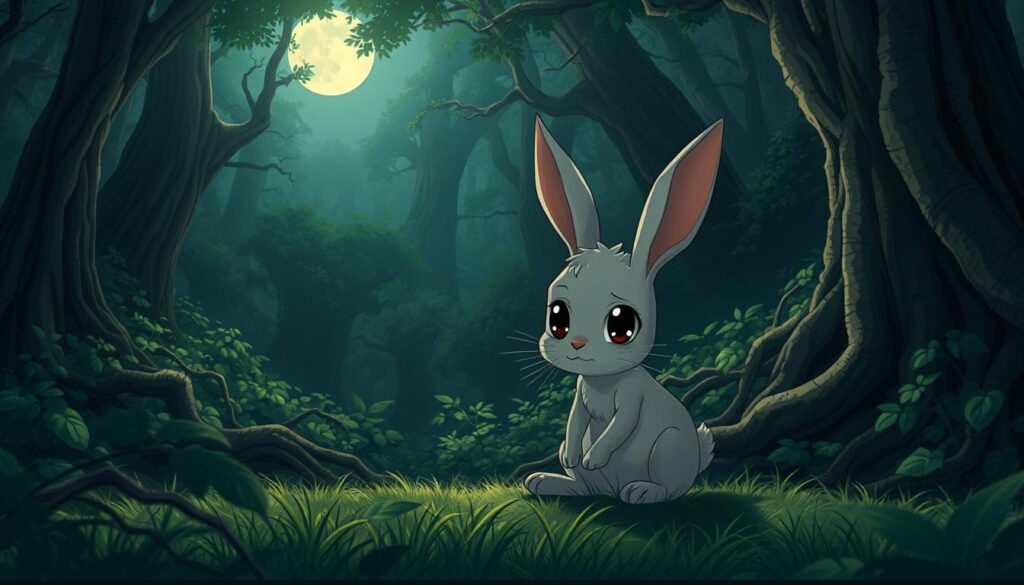
In The Rabbit Who Was Afraid of the Dark, we meet a little rabbit with big fears. The story is fun and gentle, showing kids that fear is normal. The rabbit learns to be brave and finds out that facing fears is key.
The story talks about being brave and open. The rabbit finds out that fear comes from not knowing things. He learns that facing fears helps us grow and understand more. This makes the story both fun and educational, perfect for children’s literature.
This tale shows it’s okay to be scared. The rabbit learns that knowing your fears helps you grow. It teaches kids that being brave means facing fears, not avoiding them. This story is loved by kids and parents, showing the power of children’s literature.
Why Do Rabbits Experience Fear?
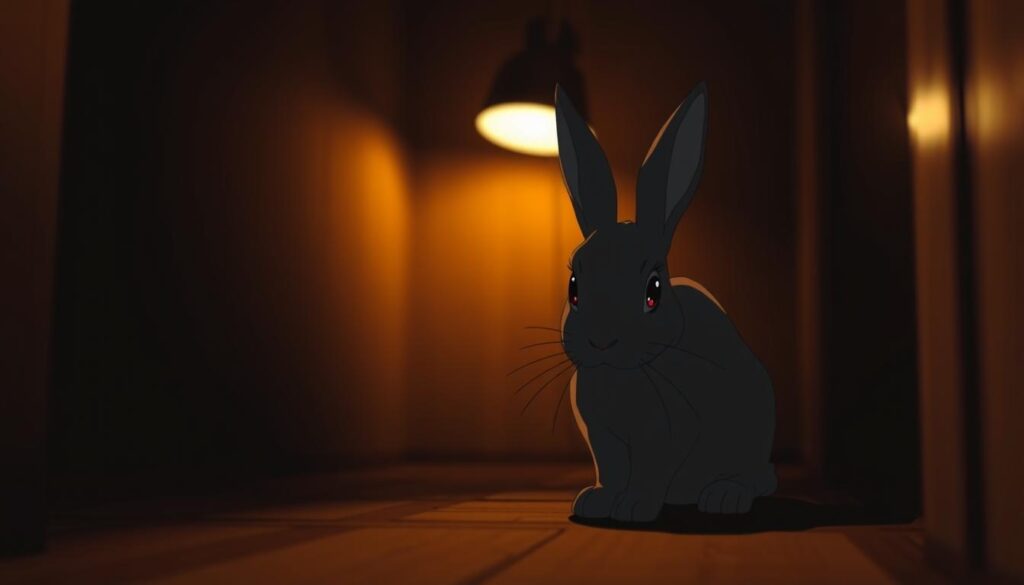
Rabbits are naturally cautious because they are prey animals. They have a strong instinct to fear. This fear helps them survive in the wild, where predators like foxes and birds of prey exist.
Many things can make rabbits nervous. Fast movements, loud noises, and strange smells can scare them. Humans, who are much bigger, can also be seen as threats. This is why children, with their loud and active nature, can be very scary for them.
When rabbits get scared, they show different behaviors. They might freeze, hide, or thump their legs to warn others. They can also become aggressive or pull away, showing their fear.
Unneutered rabbits are more likely to be aggressive when scared. Things like big sheets, loud lawnmowers, or new cleaning products can really upset them.
Rabbits like to be with friends because it makes them feel safer. When they have companions, they can handle everyday challenges better. Knowing how rabbits behave helps us understand their fears and meet their needs at home.
The Importance of Addressing Fears in Children
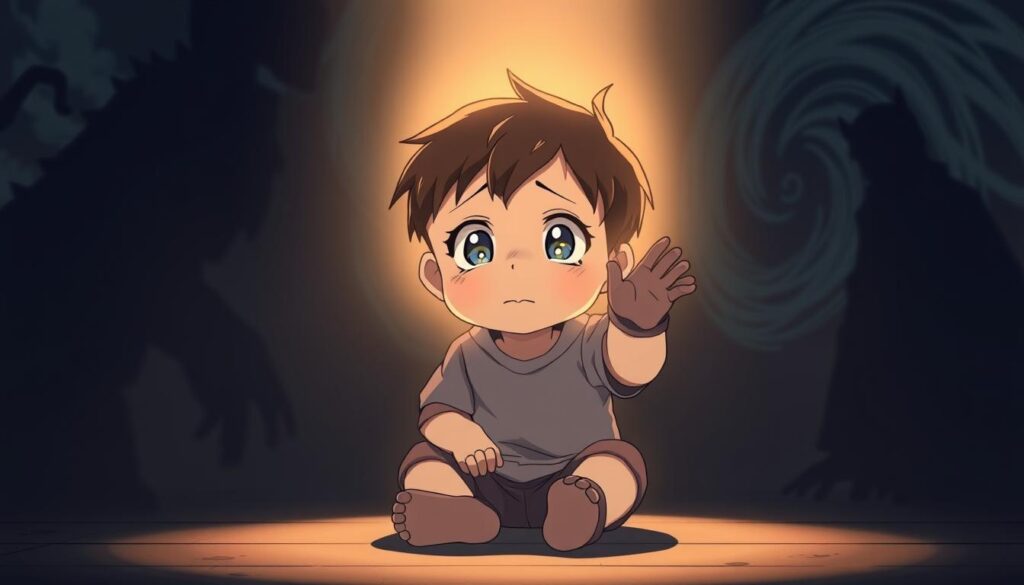
It’s key to help kids deal with their fears early on. Around age two, kids start to use their imaginations a lot. This is when fears like the dark become common.
Ignoring these fears can hurt a child’s self-esteem and daily life. It can cause lasting anxiety.
Knowing why kids are scared is important. Things like stress from parents being apart or a new place can cause fears. Having a regular check-in time can make kids feel safe.
Doing calm things at night, like reading or taking a warm bath, helps too. These activities make bedtime better.
Soft music in the background can also help with the dark. Books that talk about fears are great tools for kids. They help kids talk about their fears and find ways to deal with them.
The Rabbit Who Was Afraid of the Dark

In the tale of the rabbit who couldn’t fall asleep, we see a journey of overcoming fear. This story is loved by kids because it talks about something they can relate to. It’s known that up to 75% of kids aged 3 to 6 are scared of the dark.
The rabbit’s first steps into darkness show a common fear in kids. The story teaches us that darkness can be beautiful. It uses pictures and words to grab kids’ attention. This helps kids understand that darkness isn’t always scary.
The rabbit meets friends and learns about bravery. About 50% of parents look for books to help their kids with fears. The story’s humor and magic help kids find ways to deal with their fears.
Stories like this one help kids grow emotionally. They make kids stronger and less anxious. It’s a powerful way to help kids face their fears.
Bedtime Stories and Their Role in Overcoming Fears
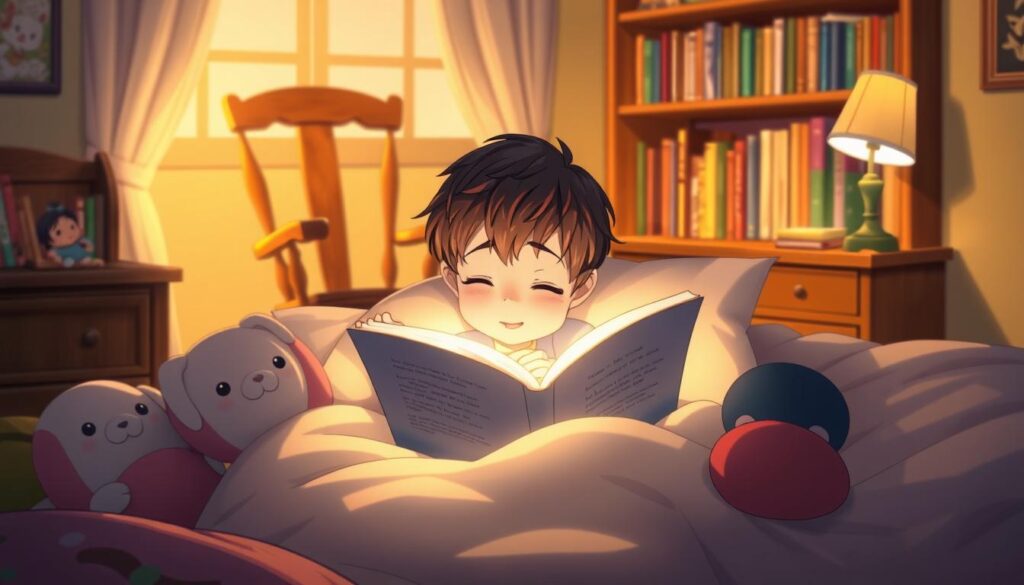
Bedtime stories are more than just a cozy routine. They help kids face their fears. Many kids are scared of the dark, with up to 75% of 3 to 6-year-olds feeling this way. Stories before bed can make them feel better.
Research shows that 85% of parents see a big drop in their child’s nighttime fears. This happens when they start telling stories at bedtime.
These stories make kids feel safe and help them understand their feelings. A survey found that 60% of parents use books to help kids deal with fears. Stories like “The Rabbit Who Was Afraid of the Dark” are popular for tackling these issues.
Stories help kids manage their emotions better. About 70% of parents see their kids handling fears better after hearing these stories.
As kids get older, they worry less about the dark. By age 7 to 12, about 50% are scared, down from 90% of preschoolers. Stories about overcoming fears make kids feel braver.
About 40% of kids who hear these stories feel they can face their fears too. Sharing these stories helps kids talk about and understand their feelings. This makes bedtime stories a great way to ease their worries.
Encouraging Courage in Kids through Literature
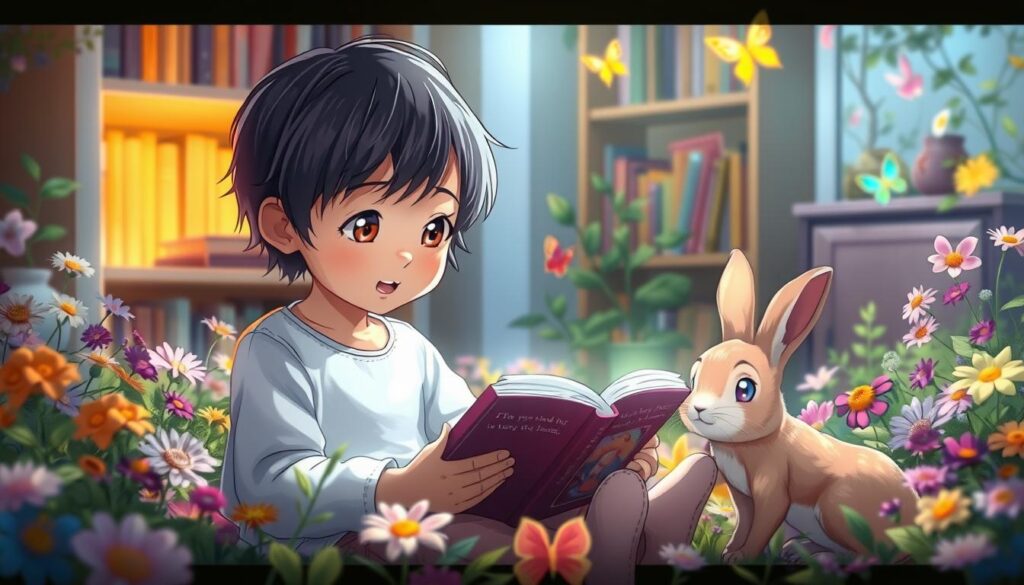
Literature is a great way to help kids feel brave. It can show them that their fears are normal. For example, “Orion and the Dark” is a story that kids love. It also comes as a movie on Netflix, showing how stories can be shared in many ways.
Many books help kids understand their fears better. “The Dark” by Lemony Snicket makes kids feel connected. “Can’t You Sleep, Little Bear?” shows how family helps when we’re scared at night.
Books like “The Owl Who Was Afraid of the Dark” teach kids that they’re not alone. They learn that everyone has fears. This makes kids feel less scared because they know others feel the same way.
Books also use humor and family to help kids feel better. The Berenstain Bears series makes kids laugh about being scared at night. “The Black Rabbit” helps kids see that shadows are not scary.
“Nightlights” shows how art can help kids deal with their fears. It’s a great way to use creativity to feel better.
Books like “Brave Squish Rabbit” and “Black Dog” deal with different fears. They teach kids how to face their fears. “Black Dog” shows that even small creatures can be brave.
These stories teach kids that fear is just a matter of how we see it. Literature can help kids become braver and more resilient. It shows them that facing fears can help them grow.
Parental Guidance: Helping Children Face Their Fears
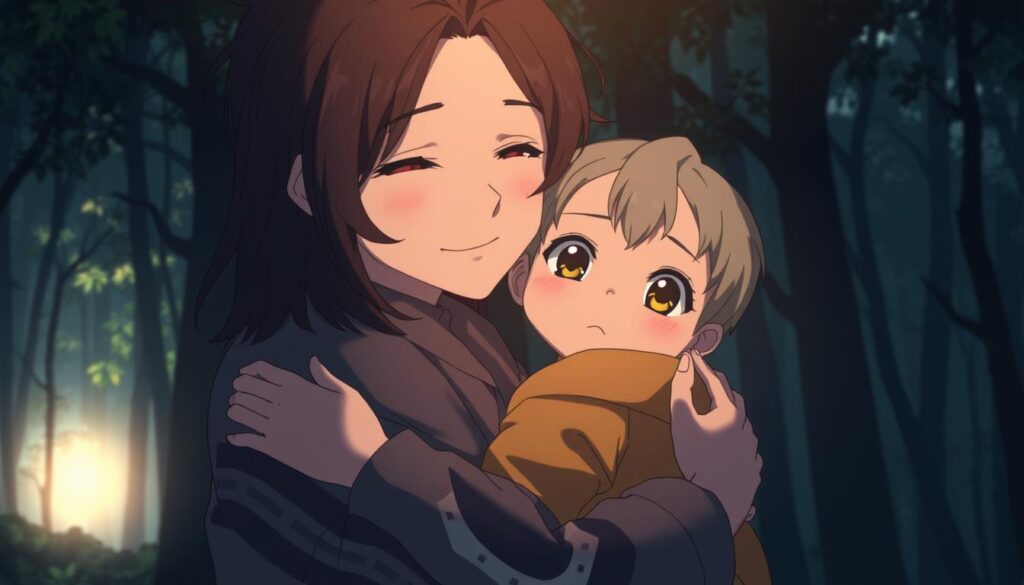
Helping kids deal with their fears is a big job. As a parent, I know how important it is to support them. By listening without judging, kids feel safe to share their fears.
Talking openly about their worries helps them understand their feelings better. This can turn scary moments into chances to learn.
Using role-playing can help kids face their fears in a safe way. Making stories that match their lives can also help. For example, stories about Orion facing fears can be very helpful.
It’s key to accept their feelings. Ignoring their fears can make things worse. But, understanding them helps kids feel braver.
Doing simple things, like making lights easier to reach, can help a lot. These steps make kids feel more in control of their fears.
Being positive and rewarding bravery can make facing fears fun. Activities like shadow puppetry or glow parties can build confidence. Being patient and consistent helps kids grow strong emotionally over time.
Conclusion
It’s very important to help kids deal with their fears. “The Rabbit Who Was Afraid of the Dark” is a great story for this. It helps kids and parents talk about fear in a kind way.
This story makes kids feel braver. It helps them understand they’re not alone in facing fears. Fears can come from many places, like family or life events.
By reading stories and talking openly, we help our kids. They learn to face their fears. This way, they grow strong and brave.

